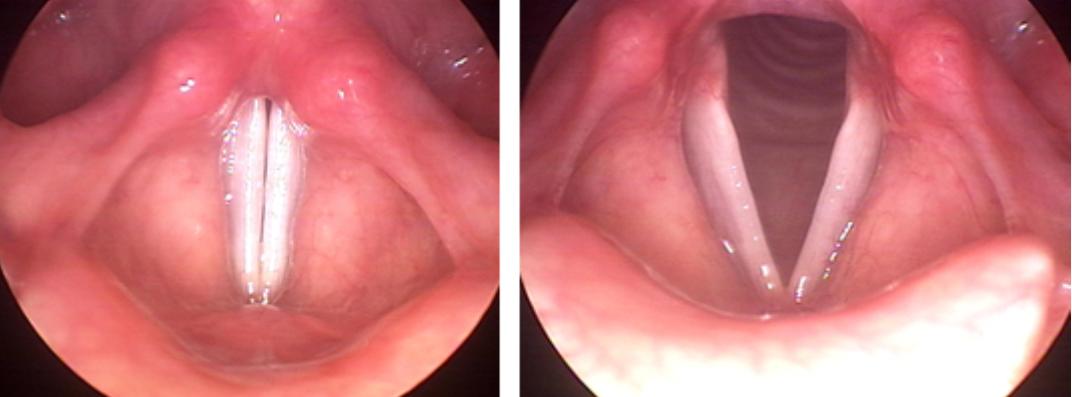Inducible laryngeal obstruction
Manchester's Premier Respiratory Clinic
What is Inducible laryngeal obstruction?
Inducible laryngeal obstruction (previously known as Vocal Cord Dysfunction)
Inducible laryngeal obstruction (ILO) is a disease where there is, inappropriate Upper airway (laryngeal) closure during the in-breath (inspiration), which causes breathing difficulties. Individuals with ILO present across varied healthcare settings with differing levels of disease severity.
ILO is defined by:
- Often sudden closure of the vocal cords and the structures in the upper airways just above the vocal cords.
- There is a sudden onset of breathlessness often (but not always) with a constriction in the neck.
- Patients complain of a wheeze on inspiration whilst asthma usually causes wheeze on the out breath.
- There are many triggers for these acute episodes of breathlessness including, irritants such as aerosols, allergens, exercise, environmental temperature changes etc.
There are 2 main types of presentation of ILO:
- ILO related to non-exertional triggers: This form presents with rapid attacks of breathlessness either due to triggers such as, exposure to airborne irritants, temperature changes, infections (sore throats, chest infections, sinusitis), heartburn, emotional stress. However, many patients report sudden onset of breathlessness without any trigger
- Exercise Induced laryngeal Obstruction (E-ILO): As the name suggest, the upper airway narrowing occurs during exercise, causing onset of breathlessness and inspiratory wheeze. E-ILO usually occurs at the height of intense exercise causing acute breathlessness which leads to individual having often to stop what they are doing. The breathlessness usually resolves rapidly on cessation of exertion but then recurs when the exercise recommences. Individuals often complain about post exertional cough, which can persist for a variable period of time. E-ILO can exist at a sub-clinical level for a considerable period of the exercise time leading to fatiguability sooner than would be expected for the individual.

Picture on left demonstrate abnormally closed vocal cords causing symptoms of severe breathlessness. Picture on right demonstrates normal vocal cords supporting effort free flow of air in and out of the lung.
Symptoms
ILO has many classical symptoms. Often individuals may only complain of a single symptom such as breathlessness or wheeze and in others all the symptoms may be present at varying times.
1. Breathlessness: this is usually comes on quickly, often (but not always) related to an identifiable trigger
2. Wheeze: the wheeze is on the in-breath as the vocal cords close during inspiration
3. Throat symptoms of tightness, discomfort, and voice changes are frequently present even when the individual is not symptomatic with breathlessness
4. Chronic cough which is dry commonly presents and some individuals is the predominant symptom.
Causes
Inducible laryngeal Obstruction has a few identifiable causes including upper airway infections, post nasal drip and gastric reflux. In many cases the cause is not definable but this does not impact on the ability of treatment improving an individual’s symptom outcome.
ILO and E-ILO have illnesses which can mimic their symptoms. This often leads to a misdiagnosis and inappropriate prescribing of medication which are ineffective.
The most common alternate illnesses diagnosis include:
- Asthma
- Breathing Pattern Disorder
- COPD
- Subglottic stenosis
Diagnosis depends ascertaining the individual’s symptom history and use of objective investigations to define the cause of breathing limitation.
Diagnosis
Diagnosis depends on ascertaining the individual’s symptom history and use of objective investigations to define the cause of breathing limitation.
- Lung function testing (LFTs): LFTs are blowing test which define the type and extent of respiratory limitation an individual may have.
- Exhaled Nitric Oxide (FeNO) analysis, is a simple blowing test taking a few minutes to undertake with near instantaneous results, which demonstrates the severity of inflammation in certain types of asthma.
- Challenge Laryngoscopy: This is a procedure whereby a fibre optic camera is used to observe the movements of an individual vocal cords whilst control exposure to causative irritant agents occurs to demonstrate inappropriate closure of the vocal cords. This process then forms the basis of treatment of ILO.
- Cardiopulmonary exercise testing (CPET) with real time laryngoscopy. This investigational technique is used to diagnose E-ILO. The CPET laryngoscopy allows assessment of respiratory, cardiac and muscle function during exercise with simultaneous review of the upper airway.
- Field exercise testing supports assessment of an individual’s breathlessness symptoms on exposure to activities that bring on symptoms
As part of our service we have access to the largest environmental chamber in europe where we can replicate environmental temperature, humidity and altitude whilst exercise is undertaken to support diagnosis of the cause of breathing difficulties.
At Respiratory Medical Ltd. We are the only current private respiratory service that has the ability to undertake all these investigation for our patients to support not only a diagnosis but also to support assessing outcome to treatment and optimisation of individual well being.

Treatments
The Majority of Individuals with ILO and E-ILO respond to specialist respiratory speech and language therapy. There are only a few respiratory speech and language therapists in the UK that have experience in managing this often complex presentation. Our team consists of nationally recognised clinicians with expertise in this field.
There are a cohort of patients who may need advanced care including upper airway Botox provided by ENT clinicians with a special interest in the management of ILO. The respiratory medical team link closely with specialist ENT teams to support best patient outcome.
Many individuals have overlap of illnesses whereby ILO exists with another respiratory disorder such as asthma, hence treating the ILO may only have partial improvement in well being. At Respiratory Medical our access to comprehensive investigative processes supports best outcomes in our patients by defining the cause of residual symptoms, to support optimum recovery from symptoms.

